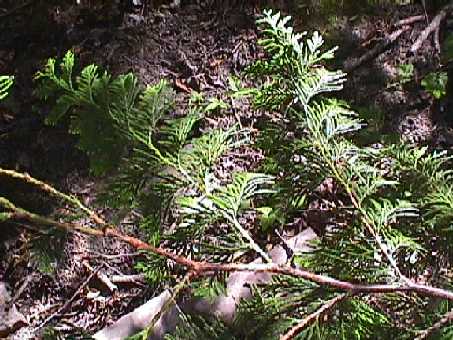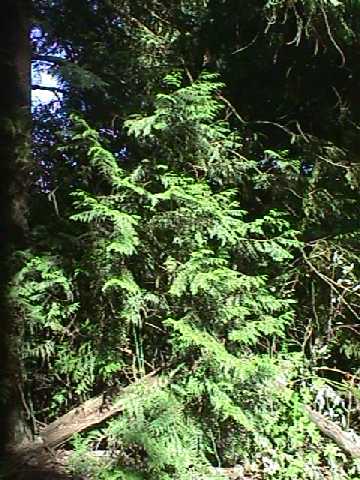

General Species Description
- Western red-cedar is a large tree growing to a height of 60m (well-developed trunk). The branches tend to spread or droop slightly and turn upward at tips (J-shaped). The bark is gray to reddish brown, tearing off in a long fibrous strip. It is evergreen tree that tends to have buttressed base.
Leaves
- Western red-cedar has a tiny (2mm), flat, opposite, yellowish green scale-like leaves, horizontally flattened pairs that overlap one another. "The leaves are evergreen, but die after 3-4 years and sometimes turn orange-brown before they fall off; new leaves are perpetually regenerated as old leaves are shed" (Guard 1995)
Inflorescence/Flowers
- The reproductive structures are in cones. Male cones are narrowly cylindrical (2mm long), dangling, reddish, and stay on the tips of the foliage (numerous).
Fruits
- The reproductive structures are in cones. Female cones are stubby (8-10mm long), occurring in clusters. "Each female cone consists of three opposite pairs of seed-bearing scales and one narrow, sterile pair at tip; seeds are 4-7mm long" (Guard 1995). It is ,woody, brown, and turned upward when matured.
Habitat
- Western red-cedar is often found in moist habitats (shaded forests) in areas of maritime climate with high rainfall. This species grows best on seepage and alluvial sites. It also grows in drier habitats; however, the species is only abundant on wet sites such as in ravines, seeps, along streams, or in poorly drained bottomlands which are typically rich soil.
Range
- Western red-cedar occurs along Pacific Coast from southeast Alaska though British Columbia, western Washington, and Oregon, reaching into coastal red wood forest of northern California. This species grows from sea level to 1250m in Washington, and up to 2500m in Southwestern Oregon. "It also occurs at moist sites in the Rocky Mountains, in Northeastern Washington, Idaho, and northwestern Montana. Found in all countries in our area" (Cooke 1997).
Similar Species
- Western red-cedar is the largest cedar in our region and it has relatively large, yellowish-green leaves. The species can distinguish from other conifers by the scale-like leaves, small thin-woody cones, and stringy red bark. "Yellow cedar (Chamaecyparis nootkatensis) has similar scale-like leaves and stringy bark but an extremely drooping habit and globose female cones" (Cooke 1997). Incense cedar ( Calocedrus decurrens) has distinctively furrowed, felty bark and small, blue green leaves. Port Orford cedar (Chamaecyparis lawsoniana) has a pleasant aroma and yellowish, flattened leaves with long, clasping bases.
Ecological Value
- Western red-cedar provides good habitat and protective cover for birds, mammals, insects, and plants. It often provides the canopy for a luxuriant undergrowth of ferns, skunk-cabbage (Lysichiton americanum), or devil's club (Opopanax horridus). The hollow stumps provide shelter for bears, raccoons, skunks, and other animals. Cedar waxwings eat its immature, blue-black cones.
Human Value
- "Western red-cedar was the most valuable tree to Native Americans inhabiting the Pacific Northwest coast, providing materials for shelter, clothing, canoes, and nets. The soft fiber of the inner layer of the bark was used for diapers, cradle padding, clothing, and blankets. Bark fiber was woven into baskets, fishing nets, and sails for canoes" (Cooke 1997). The wood was used to make, dugout canoes, house planks and posts, totem and mortuary poles, hanger, bentwood boxes, dishes, arrow shafs, combs, fish clubs, fish hangers, fish wires, masks, rattles, benches, coffins, etc. It is light, soft, weak, and brittle, but is rot-resistant for natural fungicide. It is also prized today for shingles, shakes, and boards for untreated exterior siding. This species is commonly used as an ornamental.
References
- Cooke, S. S., ed. 1997. A Field Guide to the Common Wetland Plants of Western Washington & Northwest Oregon. Seattle Audubon Society and Washington Native Plant Society. Seattle Audubon Society, Seattle WA, 12pp. B. J. Guard. 1995.Wetland Plants of Oregon &Washington. Lone Star Publishing, Richmond WA, 216pp. Pojar, J. and A. MacKinnon. 1994. Plants of the Pacific Northwest Coast. Lone Star Publishing, Richmond WA, 42pp. Turner, N.J., R.Bouchard, D. Kennedy. 1980. Ethnobotany of the Okanagan-Coville Indians of British Columbia and Washington. Occasional Paper # 21. British Columbia Provincial Museum, Victoria, British Columbia.
This page was created by: Masamichi Ogasawara, August 1999
Return to Northwest Oregon Wetland Plants Project